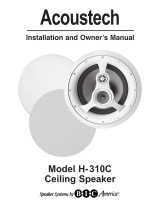Page is loading ...

CS1000S
Installation Manual
www.audac.eu

2
Introduction
In-Wall subwoofer
The CS1000S is a 10” in-wall/ceiling subwoofer speaker with a super slim design.
The built-in depth of merely 95 mm makes the CS1000S fit into almost every wall or
ceiling, and it can be painted in any desired colour to blend in with the environment the
speaker is used in.
It offers a superb reproduction of the low frequencies and is ideal to be used in
combination with other ceiling or in-wall loudspeakers like the WS and CS series.
It is made of strong ABS and equipped with the necessary installation accessories and
connection clamps for easy mounting. The cone of the speaker is treated to be completely
moisture proof, so it can also be used in damp rooms or outside applications.
The CS1000S features a 10” low frequency range woofer with an output power of
100 Watt RMS and a maximum power of 200 Watt. The speakers impedance is 8 Ohm
and it can produce a sound pressure level up to 108 dB and has a stunning frequency
response ranging from 28 Hz to 300 Hz, which is really low sound ensuring a brilliant
reproduction of the low frequencies.
Instructions
Mounting and connecting
Preparing the location
The mounting location where the speaker will be mounted to should have a thickness
between 9.5 mm and 31 mm. Behind the mounting surface, a clearance of 70 mm
should be provided to make sure the rear side of the speaker isn’t blocked. By means
of the included cutout template, the cutout hole with dimensions 270 mm x 270 mm
can be marked. After this is done, the mounting hole for the loudspeaker can be cut.

3
Painting the speaker
If you want to paint the loudspeaker to blend in with the environment the loudspeaker
is used in, first the front grill needs to be removed. This can be easily done by sticking
a thin object through the grill holes and pulling it. After this is done, the dust-cloth
behind the front should be removed, to make sure the grill holes are still open after
painting it. The painting of the speakers edge can be done by means of a roller, while
for painting the speakers grill, spray painting is recommended to make sure the grill
holes are still open after painting. After the painting is done and the speaker is dry,
the dust cloth can be placed again after the speakers grill.
Connecting the speaker
1. Route the cabling from the amplifier to the speakers desired location.
2. Separate the speaker wire, strip the cable ends and twist them.
3. Connect the speaker wires to the connection terminal. Connect the positive (+) amplifier
output to the red terminal and connect the common (-) amplifier output to the black
terminal. To connect these wires you have to press the tab, insert the wires to the
hole and release the tab. Do this twice for both of the wires.
Mounting the speaker
1. Insert the 4 long bolts through the holes in the frame. Tighten each bolt with a few
turns into the corresponding hole provided in the metal mounting frame.
2. Place the metal mounting frame through the cutout hole provided in the wall.
This can be done by first inserting the top side of the metal mounting frame through
the provided hole (The metal mounting frame at the back side of the wall, while the
plastic loudspeaker surround stays at the front side of the wall). Afterwards, lift up
the whole loudspeaker a few centimeters, so the bottom side of the metal mounting
frame can fit through the provided cutout hole.
3. Once this is done, the metal subframe is on the rear side of the wall while the
plastic loudspeaker surround is on the front side of the wall. Push the loudspeaker to
the wall making it rest on the white edge on the backside of the frame.
4. Tighten the 4 bolts evenly and make the final adjustments so the frame isn’t tilted
before fully tightening them.
5. After the speaker is secured to the wall, the grill can be placed again to the
loudspeaker. First insert the delivered ‘gum’ into the ridge in the plastic surround
wherein the grill should be placed. This prevents the grill to come loose because of
the vibrations of the loudspeaker.

4
Additional information
Technical specifications
RMS Power 100 Watt
Max Power 200 Watt
Impedance 8 Ohm
Sensitivity (1W / 1m) 88 dB
Max SPL 108 dB
Crossover Frequency 250 Hz
Frequency Response (±3 dB) 50 Hz - 250 Hz
Frequency Response (-10 dB) 28 Hz - 300 Hz
Build-in depth 95 mm
Cut-out dimensions 270 x 270 mm
Dimensions (W x H x D) 304 x 304 x 104 mm
Weight 3,6 Kg
/




